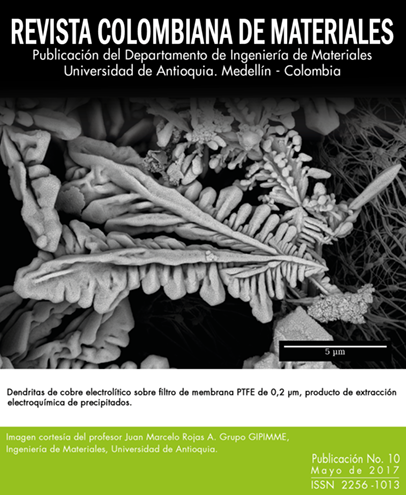Caracterización y aprovechamiento de residuos sólidos de la industria electrocerámica, como fuente de extracción de alúmina
DOI:
https://doi.org/10.17533/udea.rcm.328003Palabras clave:
residuos cerámicos, alúmina, lixiviación con ácido sulfúrico, utilización de residuosResumen
Con el fin de hacer aportes a los problemas generados por el agotamiento de los recursos naturales no renovables y al manejo y disposición final de los desechos producidos, se realizó este estudio; en el cual se evaluó la posibilidad de tratar unos residuos cerámicos de electro porcelana (RCE), los cuales contienen cantidades significativas de alúmina; para este caso en específico 26.36% p/p, dispuesto en una materia prima que contiene dos estructuras diferentes, amorfa y cristalina. En la parte experimental, se investigó el efecto de los parámetros tales como la concentración de ácido (cantidad de agua), la cantidad de ácido y la concentración de sólidos, como factores que promueven la lixiviación de los RCE. De los resultados experimentales, se observó que al lixiviar a una concentración al 20% V/V de ácido sulfúrico a 90°C, durante 3 h y con velocidad de agitación de 250 rpm se encuentra la máxima de extracción de alúmina 23.57 % p/p. El producto obtenido, después de calcinar durante 6 h a 1100°C la muestra final extraída de los RCE, fue una α-alúmina del 97.9% de pureza.
Descargas
Citas
Morán del Pozo, J. M., Juan Valdés, A., Aguado, P. J., et al., “Estado actual de la gestión de residuos de construcción y demolición: limitaciones”, Inf. La Construcción, vol. 63, no. 521, pp. 89–95, Mar. 2011.
Laner, D., Fellner, J., Brunner, P. H., “Flooding of municipal solid waste landfills--an environmental hazard?”, Sci. Total Environ., vol. 407, no. 12, pp. 3674–80, Jun. 2009.
Tabereaux, A. T., Peterson, R. D., Treatise on process metallurgy,Elsevier, 2014.
Senthamarai, R., Manoharan, P. D., Gobinath, D., “Concrete made from ceramic industry waste: durability properties”, Constr. Build. Mater., vol. 25, no. 5, pp. 2413–2419, May. 2011.
Medina, C., Sánchez de Rojas, M. I., Frías, M., “Reuse of sanitary ceramic wastes as coarse aggregate in eco-efficient concretes”, Cem. Concr. Compos., vol. 34, no. 1, pp. 48–54, Jan. 2012.
Netinger, I., Kesegic, I., Guljas, I., “The effect of high temperatures on the mechanical properties of concrete made with different types of aggregates”, Fire Saf. J., vol. 46, no. 7, pp. 425–430, Oct. 2011.
Vijayalakshmi, M., Sekar, A. S. S., Ganesh prabhu, G., “Strength and durability properties of concrete made with granite industry waste”, Constr. Build. Mater., vol. 46, pp. 1–7, Sep. 2013.
Bravo, M., De Brito, J., Pontes, J., et al., “Durability performance of concrete with recycled aggregates from construction and demolition waste plants”, Constr. Build. Mater., vol. 77, pp. 357–369, Feb. 2015.
Guerra, I., Vivar, I., Llamas, B., et al., “Eco-efficient concretes: the effects of using recycled ceramic material from sanitary installations on the mechanical properties of concrete.”, Waste Manag., vol. 29, no. 2, pp. 643–6, Feb. 2009.
Halicka, A., Ogrodnik, P., Zegardlo, B., “Using ceramic sanitary ware waste as concrete aggregate”, Constr. Build. Mater., vol. 48, pp. 295–305, Nov. 2013.
Medina, C., Frías, M., Sánchez de Rojas, M. I., “Microstructure and properties of recycled concretes using ceramic sanitary ware industry waste as coarse aggregate”, Constr. Build. Mater., vol. 31, pp. 112–118, Jun. 2012.
Xu, N., Li, S., Li, Y., et al., “Preparation and properties of porous ceramic aggregates using electrical insulators waste”, Ceram.Int., vol. 41, no. 4, pp. 5807–5811, May. 2015.
Juan, A., Medina, C., Guerra, M. I., et al., “Re-use of ceramic wastes in construction,” In: Recycl. Process. Costs Benefits, , Nova Science Publishers, Inc., 2011.
Alves, A. V., Vieira, T. F., De Brito, J., et al., “Mechanical properties of structural concrete with fine recycled ceramic aggregates”, Constr. Build. Mater., vol. 64, pp. 103–113, Aug. 2014.
Gonzalez-Corominas, A., Etxeberria, M., “Properties of high performance concrete made withrecycled fine ceramic and coarse mixed aggregates”, Constr. Build. Mater., vol. 68, pp. 618–626, Oct. 2014.
Jiménez, J. R., Ayuso, J., López, M., et al., “Use of fine recycled aggregates from ceramic waste in masonry mortar manufacturing”, Constr. Build. Mater., vol. 40, pp. 679–690, Mar. 2013.
Torkittikul, P., Chaipanich, A., “Utilization of ceramic waste as fine aggregate within portland cement and fly ash concretes”, Cem. Concr. Compos., vol. 32, no. 6, pp. 440–449, Jul. 2010.
Yao, Z. T.,Xia, M. S., Sarker, P. K., et al., “A review of the alumina recovery from coal fly ash, with a focus in china”, Fuel, vol. 120, pp. 74–85, Mar. 2014.
Park, N.-K., Choi, H.-Y., Kim, D.-H., et al., “Purification of Al(OH)3 synthesized by bayer process for preparation of high purity alumina as sapphire raw material”, J. Cryst. Growth, vol. 373, pp. 88–91, Jun. 2013.
Power, G., Loh, J. S. C., Wajon, J. E., et al., “A review of the determination of organic compounds in bayer process liquors.”, Anal. Chim. Acta, vol. 689, no. 1, pp. 8–21, Mar. 2011.
Vogel, A. I., Quimica Analitica Cualitativa Incluyendo Semimicroanalisis Cualitativo.
Das, B. R., Dash, B., Tripathy, B. C., et al., “Production of η-alumina from waste aluminium dross”, Miner. Eng., vol. 20, no. 3, pp. 252–258, Mar. 2007.
WU, C., YU, H., ZHANG, H., “Extraction of aluminum by pressure acid-leaching method from coal fly ash”, Trans. Nonferrous Met. Soc. China, vol. 22, no. 9, pp. 2282–2288, Sep. 2012.
Santini, T. C., “Application of the rietveld refinement method for quantification of mineral concentrations in bauxite residues (alumina refining tailings)”, Int. J. Miner. Process., vol. 139, pp. 1–10, Jun. 2015.
Numluk, P., Chaisena, A., “Sulfuric acid and ammonium sulfate leaching of alumina from lampang clay”, E-Journal Chem., vol. 9, no. 3, pp. 1364–1372, 2012.
Shemi, A., Mpana, R. N., Ndlovu, S., et al., “Alternative techniques for extracting alumina from coal fly ash”, Miner. Eng., vol. 34, pp. 30–37, Jul. 2012.








